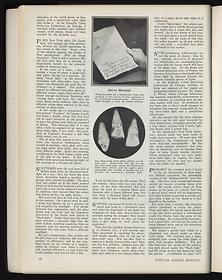Edwin W. Teale, "Weird Unseen Rays Trap Master Crooks," Popular Science Monthly, October 1931
With Wilhelm Röntgen's 1895 invention of the X-ray, and Pierre and Marie Curie's work on radium, the "ray" entered the public imagination and became an object of great fascination. The "Weird Unseen Rays" referred to here—the X-ray, ultraviolet light and polarized visible light—have all become a routine part of the arsenal of crime investigation.
Popular Science Magazine
Time4Media
Image 8 of 10
Utopian forensics
In the 19th and 20th centuries, glowing newspaper and magazine accounts of forensic technologies, real and imaginary, fueled public support for scientific crime detection. Edwin W. Teale's series of illustrated articles, published in Popular Science Monthly in 1931, conveys some of the enthusiasm for scientific crime detection. "Working slowly, painstakingly, utilizing every branch of science at hand," Teale rhapsodizes, "modern man-hunters are arriving at astonishing solutions in baffling crimes. Their work is analytical, methodical; but their results are amazing, magical."
